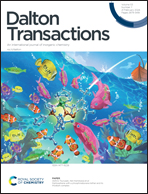Three derivatives of phenacyldiphenylphosphine oxide: influence of aromatic and alkyl substituents on the luminescence sensitization of four Ln(NO3)3 salts†
Abstract
A series of four β-carbonylphosphine oxide compounds have been synthesized, and their complexes with the nitrate salts of Sm3+, Eu3+, Tb3+ and Dy3+ have been characterized in solution and in the solid state. Analysis of the complexes using IR and NMR suggests that metal-ligand binding occurs mainly through the phosphine oxide group of the ligand, with some involvement of the carbonyl group. All 16 complexes luminesce in solutions of acetonitrile, albeit with varying degrees of intensity. The highest quantum yield values obtained for this series are those where the ligand contains an aryl carbonyl group paired with an electron rich phosphine oxide group (29.8 and 11% for the Tb3+ and Eu3+ complexes, respectively). In contrast, the longest emission lifetime values were found for complexes where the ligand contains a bulky substituent on the carbonyl group paired with an electron rich phosphine oxide (1.86, 1.402, 0.045 ms for the Tb3+, Eu3+ and Sm3+ complexes, respectively).



 Please wait while we load your content...
Please wait while we load your content...